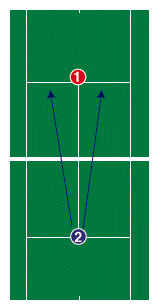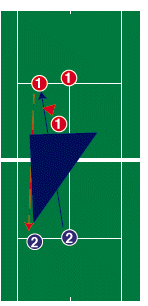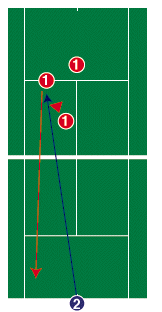|
TennisOne Lessons

Cat and Mouse: A Training Model for Positioning and Movement
Jim McLennan, Senior Editor, TennisONE
Cat: Playful, quick, patient,
silent, waits to move, pounces.
Mouse: Cornered, hapless, no
options, desperate, will move first.
To master the game of tennis, you must learn to hit sound
shots and move quickly, and really very little else. Even the sports psychologist
would agree, a good competitive attitude is of little value when the player
can't get to the ball or can't control the shot. With many of the players
that I coach, we focus on aspects of hitting or of moving, and purposely
separate them during practice. This separation enables the specific practice
of moving (gliding quickly into position) or hitting (coming against the
ball). But ... the real time connection between moving and hitting
may be the most important thing to learn. This connection is the knowing
and feeling of waiting for the opponent to hit the ball, the knowing and
feeling of when to start to the ball, and the knowing and feeling of how
to best position prior to your pounce to have the best chance to get to
the ball. Knowing and feeling, not the verbal ability to describe
how to move, but just knowing how it feels. Interestingly, some of the best
players at our club have this instinctive ability, the knack as it were,
to move to the ball quickly and efficiently. They may not have the best
hitting skills or the smoothest footwork, but again they have that instinct
for the ball. The opposite extreme is all too familiar, we all know the
player who moves too soon and is often wrongfooted, or one that moves too
late and can't get to anything. These players can improve by playing cat
and mouse.
The cat and mouse metaphor is an excellent model
that captures the feeling of waiting, of moving, and of hitting. The specific qualities of the cat and mouse predicament offer
great visual pictures, simple training models, and challenging drills.
My cat Alex was playful, harmless, and rarely killed the
little animals she captured. Once on the scent of a mouse, Alex would chase
like mad until finally cornering the animal. Now the fun (for Alex) really
began. Facing the cornered and (now) hapless mouse, Alex would crouch, perfectly
ready to pounce, and then just wait silently for the mouse
to move. The mouse, with no escape routes, would eventually move and Alex
would bat it back into the corner, to replay this game again and again and
again. Always Alex would wait, as would the mouse, when finally the mouse
could wait no longer, Alex would pounce to block the mouse's escape. Never
did Alex move first, never was Alex slow to move, and never was Alex off
balance. A great game as far as Alex was concerned. As a player,
I have been on both sides of this game. Years before I came to understand
cat and mouse, I can remember matches where I was totally frustrated, feeling
cornered, having no options, and always wondering why.
Now I realize, my opponent had controlled me, maneuvered
me into a corner, and then waited for my move (shot) to which he quickly
and easily responded. These days I much prefer being the cat.
The following drills will improve your ability to wait
and then pounce, quickly, and silently as the cat.
 1. Waiting for
the ball - When to move 1. Waiting for
the ball - When to move
This drill trains footwork reactions after the ball has
been hit rather than before. You are on the service tee, and your coach
or practice partner plays from the opposite service tee. Your partner or
coach feeds balls in a specific pattern, forehand-backhand, forehand-backhand.
You must concentrate on your footwork for these shots. Ideally the feeds
should be a just little out of your reach so that the crossover step enables
you to hit all shots with the least effort. Now ask your partner/coach to
change to a random feeding sequence. When fed with disguise, the drill will
become very challenging. Whenever you guess and are wrong footed,
understand that you have moved prior to their hit (the mouse), something
the cat never does. This drill trains the waiting, and reinforces
the correct footwork sequence to the ball.
 2. The two shot
volley sequence - Cornering 2. The two shot
volley sequence - Cornering
In this live ball drill, position as before, with the you
on the service tee and your partner or coach on the opposite service tee.
When they play their first shot off center, you must make a crossover step
to volley, but now play out the point. You should both volley in a way that
the shots can be returned (no winners). Your partner/coach must agree to
rally, and only to hit a winner if there is an obvious opening. Now, if
you move to the forehand and volley crosscourt, your partner/coach can easily
hit to the open court. (In this instance the cat-student has moved the mouse
to a corner that the cat-student cannot protect). If you move to the
forehand and volley down the line, you will more easily cover your partners
return. Moving to the first volley and playing down the line, or
in the same direction as you had moved, immediately positions you (the cat)
for the mouse's reply. A real breakthrough in understanding about how to
"corner" your opponent with your first volley. Where do you position
yourself for the volley? The short answer is "in the middle of the
probable angle of return, with some shading towards the down-the-line pass."
This enables you cover "most" but not all of your opponent's return
(you must give your opponent the perfect return). You want to be a little
closer to the line as you have less time to cover the down-the-line passing
shot than the crosscourt passing shot.The long answer to the question, where
do I position myself, is, it depends upon assessing a number of factors,
including probable angle of return, the pace, depth and direction of your
volley, the repertoire of your opponent's shots (does he have a lob or crosscourt
passing shot?), and perhaps even the game and match score (perhaps it's
time to gamble).
 3. Timing the
split step - Cornering and Pouncing 3. Timing the
split step - Cornering and Pouncing
This live ball drill is the same as the two shot volley
sequence, but now you are two steps behind the service line, and your partner/coach
is on the opposite baseline. Your objective is to play the first volley,
move forward and try to corner your partner. They should stroke the first
ball to you in this volleying position, and after your initial shot close
and time your split step to their (partner/mouse) moment of contact. If
you don't close far enough, you will be easily passed. If you close too
far, you can be easily lobbed. If you close correctly but are off time with
your split step, you won't be perfectly ready to pounce. But when you close
and time your split step just right, you will more often than not make the
successful volley. Trains quickness, timing, pouncing, and confidence in
moving to the ball.
4. Internal noise - Silence
An old friend and superb coach, Don Kerr, carried on at
length about internal noise, concentration and effortless play. He knew,
correctly, that most people could only pay attention to one thing at any
particular moment (span of control) and when two stimuli are present at
the same time confusion resulted. Tennis players contend with both external
and internal stimulation. External stimuli include our five senses (touch,
taste, smell, hear, and see). Internal noise, an additional stimulus not
in the external environment but rather within, is the actual silent dialogue
that often occurs in our head. We all have silent conversations from time
to time, "How can I be this bad", "Get ready now watch the
ball," "What if my friends can see my mistakes," "How
can I possibly explain this loss to my wife." All examples of internal
noise, and all genuine distractions when timing the split step, reacting
quickly to the opponents shot, pouncing on the ball. The cat has it so much
better than we do on this one. Having no language, the cat has no
source of internal noise. And absent of internal noise (can you
imagine a cat thinking, "what do I tell my pals if I cannot catch this
mouse") the cat is totally concentrated on the pouncing. When
some of the above drills become too challenging, and truly they will, take
a break, relax, and take a moment to diminish your internal noise.
When champions recount their greatest moments on court, they describe letting
everything flow, time slowing down, allowing themselves to play rather than
making themselves play. No internal noise, perfect concentration on the
ball, silence. So many mice, so little time.
Cat and mouse. Knowing when to move. Feeling you can get
to everything. Cornering the opponent. Waiting. Silence. Pounce. It's
fun to be the cat.
Send email to the author
We encourage you to email your comments (pro, con, appreciative, whatever)
directly to the author. To send email to Jim McLennan, click
here.
Go To:
Other Footwork Lessons In
Lessons Library
Top of Lessons Library
Back to TennisONE Home Page
What's New | Tennis
Lessons | Tennis in Your Area
Tennis Fitness | Tennis
Products | Sponsors/Advertisers/Consultants
webmaster@tennisone.com
TennisONE© is a trademark of TennisONE© and SportsWeb ONE©.
Copyright© 1995. All rights reserved.
|
|